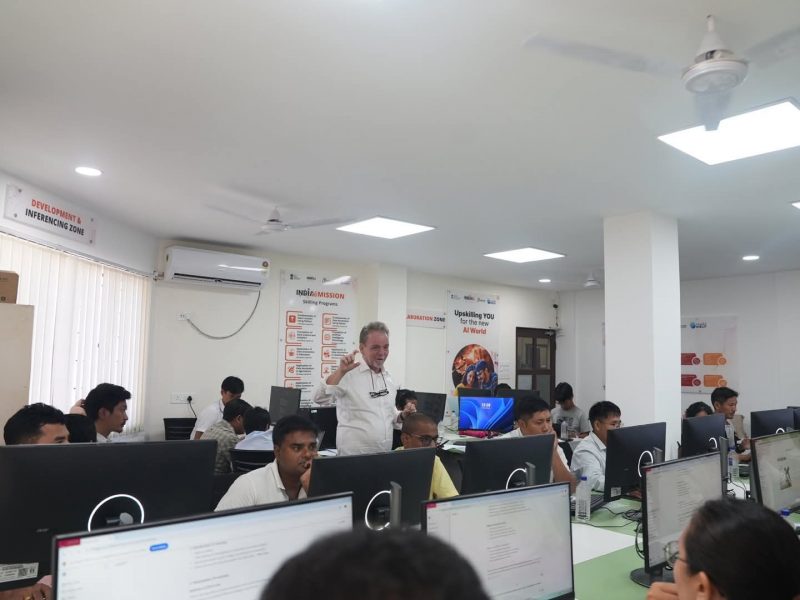The Indian higher education landscape is changing very dynamically. Against the programmatic background of the “National Education Policy 2020”, reforms are being tackled that are reminiscent of the European Bologna reform but are formulated in the 21st century. These relate to the structure of the degree programmes, central recognition of credit points, quality assurance and accreditation, internationalisation, and the design of teaching. In almost all areas, reform projects are initiated by the central government and in the states.
The goals are ambitious: substantial expansion of the student quota (from about 30% now to 50% by 2035), corresponding expansion and modernization of higher education institutions, adaptation of content to the requirements of the Knowledge Society and a striving for “world class” quality. And this is based on an unsatisfactory starting level – on which all actors agree across parties and directions. Progress and setbacks have been recorded in the reform processes, and there are sometimes fierce disputes. In many areas, it is evident again and again how challenging the tasks set are. An example is the system of accreditation of study programs and institutions.
Accreditation in India: Less participation than desired
The accreditation of degree programmes and institutions in India is voluntary, and the seal of approval awarded is intended to provide the necessary motivation. The National Board of Accreditation (NBA) is responsible for the accreditation of study programs in the technical and application area. However, as recently announced, only 15% of the programs are accredited by the NBA.
On the other hand, the National Assessment and Accreditation Council (NAAC) is responsible for the voluntary accreditation of universities and affiliated colleges. According to government data, as of 31.01.2023, 418 of the 1,113 universities were NAAC-accredited, compared to only 9,062 of the 43,796 colleges, quoted in the Indian Express.
Overall, the accreditation system for higher education institutions in India is quite inconsistent, as The Print describes:
“Currently, there are multiple agencies for the accreditation of institutions. Apart from the UGC, which grants recognition to institutions, there is NAAC, which does assessment and a graded accreditation of HEIs at the institution level, over 5-year periods. The NBA does binary accreditation of programmes in technical disciplines for either 6-year or 3-year periods. The AICTE [All India Council for Technical Education] does the mandatory annual approval of all programmes/courses in technical educational institutions etc. The IITs conduct their own internal peer review, which does not involve any of these agencies.”
National Accreditation Agency NAAC in trouble
The national agency NAAC is also in serious trouble at the moment. On 03.03. it was reported that the previous chairman of the Executive Committee, BHUSHAN PATWARDHAN, had threatened to resign on 26.02. after only one year in the post. The reason given was that his request for the University Grant Commission (UGC) to set up a committee to investigate irregularities in the NAAC was not met. BHUSHAN sees a need for action due to “vested interests, [and] malpractices”, which allegedly lead to universities receiving “questionable grades” in accreditation. There would be irregularities such as the non-transparent, random selection of reviewers or a corrupted database with unregulated access authorizations. Overall, the accreditation system of the NAAC is considered to be in the worst possible condition and reputation.
However, the threat of resignation unexpectedly led to the chairman of the UGC (KUMAR) appointing a new (additional?) NAAC chairman was appointed without consulting BHUSHAN, according to his own statement. Meanwhile, the new chairman, ANIL SAHASRABUDHE, promised to avoid old mistakes. In this way, the IT problem should be tackled immediately. On 10.03. The Print that the overarching NAAC director, SC SHARMA, defends the NAAC’s existing accreditation system as “robust, transparent and regulated” overall. Nevertheless, the newly appointed chairman has initiated a series of immediate measures to counter the grossest allegations. Among other things, access to the database is to be administratively limited, the survey among students is to be made more secure, external agencies are to be selected more transparently and randomly, and the selection of experts for the inspections is to be freed from manual influence.
What’s next? “National Accreditation Commission”
What the future of quality management could look like at the national level is currently being explored on the occasion of the revision of the accreditation guidelines of the Indian Institutes of Technology (IITs). Today’s 23 IITs play a special role in India, they report directly to the Ministry of Education, are relatively well equipped and have a high degree of autonomy, e.g. in accreditation through internal peer procedures. IITs are transmission belts of national technology and higher education policy and drivers of innovation. Now the IITs, as flagships of Indian higher education, are to be brought under the uniform accreditation and ranking portal “ONOD – One Nation One Data“. The vision, also a measure of the NEP 2020, is to create a data-driven, transparent accreditation under the auspices of a “National Accreditation Council” using a uniform, technology-supported system. In November last year, the Ministry of Education presented the report of a commission describing the restructuring of the accreditation system and formulating concrete implementation steps. Accreditation is therefore to be simplified and made more transparent. In the future, quality control is to be ensured by accreditation institutions, tailored to university types and outcome-oriented. The focus is still on voluntariness, but this is to be stimulated by means of “empirical politicy benefits”.

All URLs in the order in which they appear in the text:
03.03.2023 – NAAC executive panel chief wants to quit | India News – Times of India
05.03.2023 – UGC Probe Sought After N Charge Given To Ex-AICTE Chief | Mumbai News – Times of India
10.03.2023 – NAAC Director rejects claims of irregularities in functioning – ThePrint – ANIFeed
12.11.2022 – One nation, one data: NAAC Chairman | Mumbai news – Hindustan Times
21.04.2023 – Ministry of Education plans to develop a two-tier accreditation system – Times of IndiaDEPARTMENT OF HIGHER EDUCATION, MINISTRY OF EDUCATION, GOVERNMENT OF INDIA. (2023). REPORT OF THE OVERARCHING COMMITTEE CONSTITUTED BY MINISTRY OF EDUCATION IN NOVEMBER 2022. (PDF)



